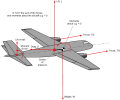I'm trying to understand a concept in the PHAK. Chapter 10 (weight and balance) states that:
"Tail heavy loading also produces very light control forces, another undesirable characteristic. This makes it easy for the pilot to inadvertently overstress an aircraft."
The "Tail heavy loading" above is meant in reference to loading with an aft center of gravity and the effects of stability. The book does not further explain how an aft CG causes light control forces and I'm trying to understand how. The only explanation I've been able to think of would be that perhaps the aft CG also means that the arm from the CG to the tail is shorter, and therefore your tail forces have less leverage to rotate the airplane's nose up and down.
Can anyone explain this further?
"Tail heavy loading also produces very light control forces, another undesirable characteristic. This makes it easy for the pilot to inadvertently overstress an aircraft."
The "Tail heavy loading" above is meant in reference to loading with an aft center of gravity and the effects of stability. The book does not further explain how an aft CG causes light control forces and I'm trying to understand how. The only explanation I've been able to think of would be that perhaps the aft CG also means that the arm from the CG to the tail is shorter, and therefore your tail forces have less leverage to rotate the airplane's nose up and down.
Can anyone explain this further?

